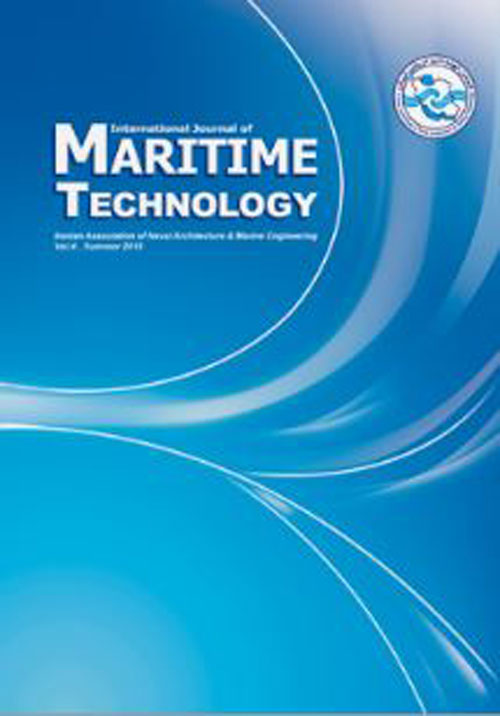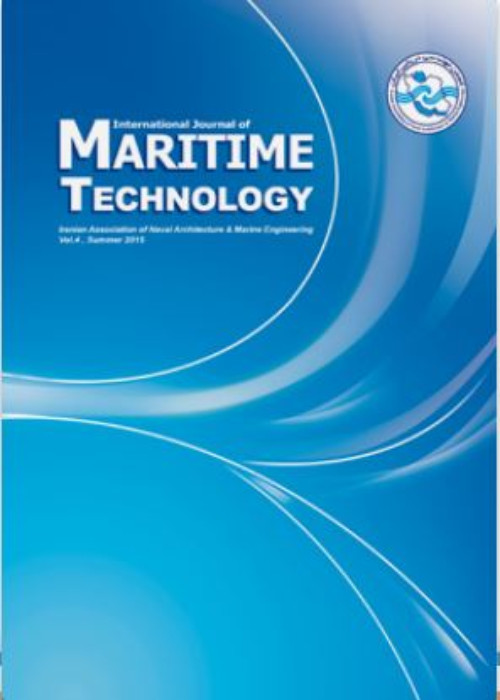فهرست مطالب

International Journal of Maritime Technology
Volume:8 Issue: 13, Autumn-Winter 2020
- تاریخ انتشار: 1399/06/04
- تعداد عناوین: 6
-
-
Pages 1-9
This study analyses two comparison examples (hurricanes Frances versus Jeanne and hurricanes Rita versus Irene) to account for the catchment characteristics and social factors for the area impacted by the track of a tropical cyclone. This will result in a way of categorizing tropical cyclone, which can be combined with the previous meteorological indexes to better assess the potential impact of each tropical cyclone from a hazard mitigation and the disaster response perspective. Given that the highest correlation between fatalities and damage occurs for the rainfall index TCRI, vulnerability to rainfall was selected as the focus of the research. The results show that the impacted areas and the population who lives in the impacted areas are two important indicators of flood vulnerability. The new index (TRI) yields a lower RMSE in rank position, at 3.5 and 2.2, compared with the SSHE at 5.8 and 5.7 for selected hurricane damage and death toll, respectively.
Keywords: Tropical Cyclone, Hurricane Hazard, Risk Index, Land Characteristics, Social factors -
Pages 11-19
Partially submerged propellers function in two-phase condition, i.e. each propeller blade enters water once in each revolution so the thrust and torque of each blade hit maximum level and then become around zero. Surface-piercing propeller investigated in this work is a new geometry that the main purpose of its design has been to achieve higher hydrodynamic performance; minimizing energy loss by reducing of the volume fraction of the water adhered to the exiting blade from the water surface. In this article, Reynolds-Averaged Navier–Stokes computations based on finite volume method (FVM) was applied to investigate force excitation, ventilation pattern and wake formation of the partially submerged propeller under inclination angle. Two-phase flow field equations were solved using homogenous Eulerian multiphase model by sliding method. To solve two-phase flow field at the free surface accurately and deal with free surface effects in calculations, CFX free surface model based on volume of fluid (VOF) approach was used. The accuracy of the numerical method was verified using series of simulations on SPP-841B propeller with existing experimental measurements. Comparison between simulated and measured SPP-841B open characteristics as well as ventilation pattern of the key blade indicated a reasonable agreement with experimental data and observations. Based on obtained data, with an increase in shaft inclination angle, propeller thrust and torque coefficients increased, whereas the propeller efficiency was decreased.
Keywords: Partially submerged propeller, Ventilation pattern, Wake formation, Inclination angle -
Pages 21-29
Pitting is one of the most localized forms of corrosion attacks which cannot be detected easily. Pitting decreases the pipe wall thickness and also the pipeline strength against environmental and operational loads. The purpose of this article is to investigate the most common reliability methods for estimating the maximum pitting depth and the effect of internal pressure on the remaining strength of corroded pipelines at different times in its lifetime service based on different failure pressure models using first-order approximation and sampling reliability methods. To investigate the effect of pitting growth and variation of internal pressure on pipeline characteristics, sensitivity analysis with gamma index several times in pipeline lifetime was performed. It is concluded that the first-order reliability method was applicable for ASME failure pressure models, also concluding that internal pressure and pipeline wall thickness are the most effective load and capacity parameters in failure probability of corroded pipelines. The reliability analysis was performed for two pipeline classes and two different pipeline wall thicknesses and it is concluded that the increase in pipeline wall thickness has more effect on decreasing the probability of failure (POF) of the pipeline than using a pipeline with higher classification.
Keywords: Offshore Pipeline, Reliability Methods, Corrosion, Probability of Failure -
Pages 31-39
Red tide is a phenomenon that occurs by rapid growth or proliferation of toxic algae. The growth and spread of this phenomenon can threaten marine ecosystems, human health, aquaculture, water desalination plans, tourism and fisheries industries. Ocean currents are one of the affecting factors of the distribution of this phenomenon. In this study, the role of ocean current in chlorophyll-a distribution is investigated on the north coast of the Arabian Sea, the Sea of Oman and the Persian Gulf. The monthly MODIS satellite chlorophyll-a concentration data is used to study the red tide and the HYCOM model analysis result to study the current ocean pattern from 2002 to 2018 and in 2016 as an example. The currents in this area cause chlorophyll-a spreading and transfer of nutrients necessary for chlorophyll-a proliferation and red tides events. There are four main sources of chlorophyll expansion and proliferation in the region: the eastern shores of the Arabian Sea, the northern shores of the Arabian Sea and the Sea of Oman, the Strait of Hormuz, and the northwestern shores of the Persian Gulf. The northeastern currents in East Oman transport chlorophyll to the north of the Arabian Sea and the northwestern currents in the west of the Arabian Sea move chlorophyll from the coasts of India and Pakistan to the west and dispersed it to the west in the northern shores of the sea of Oman.
Keywords: Chlorophyll-a, Ocean Current, Persian Gulf, Sea of Oman -
Pages 41-49
To extract valid results from time series analysis of tides observations, noise reduction is vital. This study aimed to use a precise statistical model to investigate noise types. Noise component amplitude of the proposed model was studied by Least Square Estimation (LS-VCE) through different statistical models: (1) white noise and auto-regressive noise, (2) white noise and Flicker noise, (3) white noise and random walk noise, (4) white noise and Flicker noise and random walk, and (5) auto-regressive noise and Flicker noise. Based on the values obtained for the Likelihood Function, it was concluded that the noise model that can be considered for observations of the Buoy time series includes two white and Flicker noises. In addition, tide forecasting for all stations was done by extracting important frequency calculated in two cases: (1) the first case in which matrix of observation weight matrix was considered as the unit matrix or the noise model was just a white noise (2) the case in which matrix of observation weight matrix was considered as a combination of white and Flicker noises. The results show that use of precise observation weight matrix resulted in 11 millimeter difference compared to the case in which observation with unit weight matrix was used.
Keywords: Buoy station’s time series, Least Square Estimation, Least Square Harmonic Estimation, tides observation’s noise analysis, Maximum Likelihood Estimation -
Pages 51-59
In recent decades, there has been a growing demand for composite materials with high strength to weight ratio and high stiffness to weight ratio for use in the marine industry to improve the hydrodynamic and structural performance of vessels and propulsion systems. Apart from the advantages of composite propellers over their metal counterparts, deformations of these propellers under loading can alter their hydrodynamic effects. This paper was a hydroelastic analysis of a composite marine propeller made of carbon fiber laminate. This analysis was performed by the use of CFD-FEM based on the two-way fluid-structure interaction (FSI) coupling on the 3D geometry of the KP458 propeller. The CFD results are compared with the experimental data reported by Hyundai Maritime Research Institute (HMRI), for advance ratios of 0.1-0.5, which shows a perfect agreement among them. An increase in the efficiency of the flexible propeller is observed in different advance ratios due to an increase in thrust (1-4%) and a decrease in torque (1-6%).
Keywords: Hydroelastic, Composite propeller, Hydrodynamic performance, FSI


